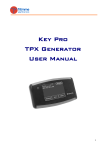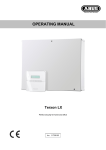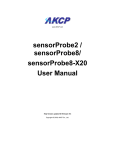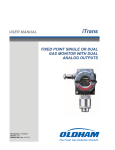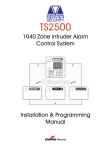Download Installation & User Guide
Transcript
CPA6 Installation & User Guide Compatible Equipment CPA6 OM - Output Module 9040 - Loudspeaker DC54/58 - Digital Communicators (Stand Alone Only) 496524 Issue A 1 of 16 CPA6 CPA6 Overview Introduction Facilities The CPA6 multizone alarm control panel has been manufactured under exacting quality control standards and incorporates the latest proven electronic technology and high quality components to assure outstanding and lasting performance. The panel offers the following facilities as standard:- T h e u n i t co mp lie s w it h B ritish Standards recommendations (BS4737 Parts 1 and 2). The micro-processor based panel caters for alarm systems of up to sixty circuits and is easily installed to provide highly effective system control and monitoring. Its main advantages include:l l l l l l SIMPLIFIED INSTALLATION WIRING, reduced time and costs. ENGLISH TEXT DISPLAY, shows all faults, alarms and operating directions. EVENT MEMORY, related to date and time , stores all events, alarms, opening and setting etc., in reverse order of occurrence. INTERNAL ELECTRONIC SOUNDER, differing tones avoid the need for separate audible devices. SIMPLE OPERATION, reduced commissioning, training and servicing costs. NUMEROUS STANDARD FEATURES. INPUTS Up to 60 individually controlled and indicated detection circuits may be connected (10 per zone interfaced via remotely positioned Zone Expansion Module or ZEM) ENGLISH TEXT DISPLAY Provides fully detailed information of system status, detection circuit conditions, and in addition, all User and Engineer prompts necessary for the operation and programming of the system, for example “Call Alarm Company to reset system”. This prompt statement is displayed to the User when he attends the panel following an alarm or fault and an ‘Engineer Reset’ operation is required. EVENT MEMORY All alarm/fault conditions and panel status changes (e.g. opening and setting, identification of shunted circuits, etc.) are stored with date and time reference. All relevant events can be recalled on the panel’s display by the User, following an alarm or fault condition. The alarm company engineer may recall the entire stored log to the display, or alternatively onto a portable printer; and in addition to all alarm and fault events, will also be able to examine the times of opening/setting, which user opened/set the alarm system, and which detection circuits were isolated at the time of each setting operation. The memory cannot be cleared manually and will always contain the latest forty events in reverse order of occurrence, (latest event - first). CPA6 2 of 16 496524 Issue A CPA6 Circuit Wiring and System Expansion Introduction TYPE 2 - 24-hour Circuit This type is selected when continuously monitored detectors are connected, (typically fire doors, tube and wire framing etc). Circuit operation will cause the fault audible tone, when the system is open, and a main alarm condition when the system is set. Reference will be made to Zones and Circuits when explaining typical configurations. It is therefore necessary to understand the difference between them when used in this context. It will be helpful to refer to Figure 1 (page 5) which shows the connection and use of end-of-line and shunt resistors across normally closed contacts. TYPE 3 - Double-Knock night circuit This option is programmed where two devices have to be operated simultaneously when the alarm system is set, before an alarm condition is generated. Normally closed circuits Each detection circuit may have up to ten normally closed (N.C.) contacts, excluding tamper only type (0), 2 knock-night type (3) and shunt-lock circuit type (6). NOTE: During setting, if either of the two devices Each contact must have a 4k7 shunt resistor fitted to connected to this type of circuit is operated, then a enable the CPA6 to continuously monitor the circuit fault condition will occur, which will inhibit the system wiring. from being set. An end-of-line (E.O.L.) resistor must always be fitted to TYPE 4 - P.A. Circuit each circuit. Detection circuits may be wired in twin This definition is given to Personal Attack buttons cable, and make use of a remote resistor at the ‘End of and any other detectors which are required to Line’. operate the panel’s P.A. output only. This type of circuit is always active. Alternatively, if four core cable is used, the E.O.L. resistors fitted at the termination block of the control panel may TYPE 5 - Exit/Entry Route Circuit (intermediate) be utilised for detection circuits wired directly to the Detection circuits that may be operated during control panel. exit and entry are defined thus. This type of circuit is shunted during authorised entry to the Tamper Contacts premises, but will cause a main alarm if Tamper contacts are wired in series with the detection operated whilst the system is set. circuit and no shunt resistor is fitted. NOTE: The tamper link/contact of a detector device must be wired in the opposite leg of the circuit to the detector contact. TYPE 6 - Last exit contact/Shunt lock circuit Either the final exit door contact, or shunt lock fitted to the final exit door must be defined as this circuit type. Detection Circuits TYPE 7 - Test circuit Full details of the first operation of a detection circuit defined thus, will be stored in the panels event log, but will not cause any operation of alarm fault outputs. A circuit on test and in fault condition will not inhibit setting the alarm system. Detection circuit types, e.g. P.A. 24 hr. etc. connected to each zone or Z.E.M loop are defined during commissioning and can be any of the eight types listed below:- CIRCUIT TYPES TYPE 0 - Tamper-only circuit This definition is given to a detection circuit not connected at the commissioning stage, (i.e. circuits available for future expansion). TYPE 1 - Night circuit Where detection circuits are to be active only when the system is in the test/set condition, this definition is used. 496524 Issue A The following types of detection circuits may additionally be programmed as User ‘shuntable’;a) Type 1 - Night circuit. b) Type 2 - 24-hour circuit - may be made shuntable only whilst the alarm system is open. c) Type 3 - 2 knock night circuit. d) Type 5 - Exit/Entry (intermediate) circuit. 3 of 16 CPA6 CPA6 NOTE: All detection devices connected to an individual circuit must be of the same type. Outputs P.A. Detection Zones and Zone Expansion (The CPA6 has six zones. Each zone may have one circuit only, or can, by the addition of external Zone Expansion Modules, (Z.E.M.’s) be expanded in increments of two circuits, up to a maximum of ten (see figure 1). Z.E.M’s are housed in small tamper-protected metal/plastic enclosure and would normally replace a junction box in the location of the detectors. The enclosure tamper switch is connected into loop ‘A’ of a Z.E.M. internally. Two different types of detection circuits may be connected to a single Z.E.M and each identified during the commissioning procedure. Z.E.M’s are interconnected with two wires, the output of one Z.E.M. connecting to the input of the next. Up to five Z.E.M.’s can be connected in this manner into a single CPA6 zone input. Circuit identification is achieved by noting the position of each Z.E.M. in its associated group e.g. Zone 4 circuit 6 refers to the circuit connected to the ‘B’ loop of the third Z.E.M. on the input to Zone 4 of the panel. NOTE: Z.E.M. Interconnection is polarity conscious. This drives high (to + 12V via a 47R resistor) for signalling purposes following activation of any P.A. circuit. ALARM This drives high (to + 12V via a 47R resistor) for signalling purposes following activation of any detection circuit (excluding P.A. Circuits) when the system is set. SET This drives high (to + 12V via a 47R resistor) for signalling purpose when the alarm system is set. The output is removed as entry to the premise commences. E/E This drives high (to + 12V via a 47R resistor) when the system is being set or opened. 24HR/FAULT This output drives high (to +12V via a 47R resistor) following operation of 24 hour or tamper circuits during the day, or any fault condition during system setting. BELL RELAY This output is a voltage-free normally open relay contact which closes an alarm, following any programmed bell delay. The contact will remain closed until either the alarm system is reset, or a pre-set bell duration time expires. When a Zone has only a single circuit wired to it, the Z.E.M. -ve input connection on the CPA6 PCB is ignored and the +ve & -ve terminals are used for the detection NOTE: When the panel supply is switched via the relay circuit, with the E.O.L. terminals providing the end of line contacts to drive an external bell, the bell must be of a resistor. ‘suppressed’ type. Detection circuit wiring to Z.E.M.’s is via terminals ‘Loop A’ and ‘Loop B’ and the E.O.L. resistors must be remote from the Z.E.M fitted. AUX SUPPLY This output is individually fused (FS1) and provides 13.6 volts dc @ 300mA (max) for external equipment. SPEAKER This output drives the integral sounder speaker, but may also be used to drive an additional extension speaker (8 Ohm) where required. CPA6 4 of 16 496524 Issue A CPA6 Zone Wiring NOTE: Up to five Z.E.M.’s may be fitted to one zone of the CPA6, to provide a maximum of ten individually controlled/indicated detection circuits per zone. 2-wire configuration using remote EOL resistor N.C. Detector 4K7 contact contact & tamper shunt resistor switch/link On no account must the Z.E.M. Interconnection wiring be used to power other devices. Mat CPA6 Main Control Board Terminals ZONE 1 Up to 10 N..C. Detector contacts may be fitted on any detection circuit (except circuits programmed as L/x/S1, or, 2-knock night). 2K2 E.O.L resistor ZONE 1 - CIRCUIT 1 Z.E.M + ZONE 2 + E.O.L. Res Z.E.M - ZONE 3 + E.O.L. Res Issue 5 Z.E.M.’s also contain 2 spare terminals marked ‘A’ and ‘B’ which can be used as a junction point for power cables. 4 wire configuration using panel EOL Resistor E.O.L. Res Z.E.M - Correct polarity and orientation must be observed when connecting Z.E.M.’s ZONE 2 - CIRCUIT 1 ZONE 3 - CIRCUIT 1 1 + 2 CLK 3 2K2 E.O.L. Resistor 4 5 0 INPUT Loop A 6 ZONE 3 - CIRCUIT 2 (e.g spare circuit for future use) 7 Loop B 8 0 CLK 9 2K2 E.O.L resistor OUTPUT 2 off connectors for use as Junction Block for 12V auxiliary supply 0 + ZONE 3 - CIRCUIT 3 1 + 2 CLK 3 0 2K2 E.O.L. Resistor 4 INPUT Loop A 5 6 7 8 2K2 E.O.L. Resistor Loop B 0 OUTPUT 9 CLK 0 + ZONE 3 - CIRCUIT 4 Fig 1 Circuit Wiring 496524 Issue A 5 of 16 TO OTHER Z.E.M.s (Max 3) CPA6 CPA6 Output Table TABLE 1 CIRCUIT TYPE TYPE 0 TAMPER ONLY CIRCUIT TYPE 1 NIGHT CIRCUIT TYPE 2 24 HOUR CIRCUIT TYPE 3 DOUBLE KNOCK NIGHT CIRCUIT TYPE 4 P.A. CIRCUIT TYPE 5 EXIT/ ENTRY CIRCUIT PANEL STATUS “OPEN” 24Hr/Fault O/P Fault Audible (L) ------------ 24Hr/Fault O/P Fault Audible (L) ------------ P.A. Alarm O/P Main Audible (L) “TEST” “EXIT” 24Hr/Fault O/P Fault Audible (L) 24Hr/Fault O/P Fault Audible (NL) Main Alarm O/P Main Audible (L) Main Alarm O/P Main Audible (L) Main Alarm O/P Main Audible (L) Main Alarm O/P Main Audible (L) 24Hr/Fault O/P Fault Audible (NL) 24Hr/Fault O/P Fault Audible (NL) Main Alarm O/P Main Audible (L) Main Alarm O/P Main Audible (L) 1, or 2 Devices Operated: 24Hr/Fault O/P Fault Audible (NL) P.A. Alarm O/P Main Audible Tamp/Fault O/P (L) 1, or 2 Devices Operated: 24Hr/Fault O/P Fault Audible (NL) P.A. Alarm O/P Main Audible Tamp/Fault O/P (L) SHUNTED BY PANEL 2 Devices Operated: Main Alarm O/P Main Audible (L) 2 Devices Operated: Main Alarm O/P Main Audible (L) P.A. Alarm O/P Main Audible (L) P.A. Alarm O/P Main Audible (L) Main Alarm O/P Main Audible (L) SHUNTED BY PANEL ------------ TYPE 6 LAST EXIT/ SHUNT-LOCK CIRCUIT ------------ 24Hr/Fault O/P Fault Audible (NL) TYPE 7 TEST CIRCUIT ------------ 24Hr/Fault O/P Fault Audible (NL) INITIATES SYSTEM SETTING ------------ Output Table Table 1 shows the Outputs and Audibles that are operated following an activation of one of the circuit types, with the alarm system in its various states. 2 Latching and Non-latching conditions are denoted by 3 ‘L’ and ‘NL’ in brackets. Note: Shuntable circuits (i.e. Those which an authorised user can isolate prior to setting the alarm system) can be tested whether isolated or not. CPA6 “ENTRY” 24Hr/Fault O/P Fault Audible (L) 24Hr/Fault O/P Fault Audible (NL) 24Hr/Fault O/P Fault Audible (NL) 1 “SET” 4 INITIATES SYSTEM OPENING ------------- ------------ ------------- The table assumes that no bell delay is selected: If bell delay is selected, operation of the bell relay and of the internal main alarm audible, is delayed by the period set. Following a tamper or 24 hour alarm in ‘SET’, on ‘Opening’ the tamper/fault output will operate together with the internal local audible. The main alarm audible will sound if P.A. Circuits have been programmed to sound during the open (’DAY’ condition). 6 of 16 496524 Issue A CPA6 Key Functions Engineer Operation Fuses The alarm engineer can only gain access to the control FUSE 1 panel’s programme by entering a four digit ‘Engineer Code’. Is rated at 2A and is of the Quick Blow type. Its function is to protect the + 12v auxiliary output from overloads. Following entry, the control panel tamper protection is disabled enabling free access to the enclosure. Failure of FS1 will result in removal of the + 12v auxiliary output. NOTE: The Engineer Code is NOT recognised when the FUSE 2 alarm system has been set by an authorised User. Is rated at 1A and is of the Anti-Surge type. Its function is to protect the supply to the CPA6 circuitry from overloads. T o c h ang e s y s tem commissioning:- - p arameters follow ing Enter Engineer Code Open control panel lid Operate Write Protect switch SW1 to ‘OFF’ position Answer ‘YES’ and ‘NO’ as appropriate to automatically displayed statements to advance the program to the first step where a change of parameter is to be made Change parameter(s) as required Move ‘Write Protect’ (SW1) to ‘ON’ position Close panel lid and secure. Enter Engineer Code to return control panel to the open status. Power down panel mains and battery. Operate write protect switch SW1 to OFF position. Power up panel battery and mains. Enter 1234. The system is now back to Factory Default Parameters. Please refer to page 15 496524 Issue A FUSE 3 Is rated at 500mA and is of the Quick Blow type. Its function is to protect the supply to Z.E.M's and detection circuits from overloads. Failure of FS3 is always identified by the event “OPEN TAMPER” on all detection circuits, and failure to identify Z.E.M’s. FUSE 4 Is rated at 2A and is of the Quick Blow type. Its function is to protect the supply to the internal sounder from overloads, which is defined as a sounder impedance of less than 4 Ohms. Failure of FS4 will result in a drop in audible level of the internal sounder. SCAN FAULT “SCAN FAULT” will be logged if the CPA6 cannot sensibly ascertain the status of any detection circuit for a period of three scan cycles. Loading Defaults Bell Test/Walk Test Failure of FS2 will result in the CPA6 display blanking and the keypad tone failing to operate. All detection circuits will cease to function. Should a scan fault be encountered, the detection circuits and Z.E.M interconnection wiring should be tested to ensure that the earth leakage resistance is greater than ½ MΩ for detection circuits and 2 MΩ for Z.E.M wiring. Other potential sources of scan fault can be avoided by ensuring that Z.E.M interconnection and detection circuit cables are not laid adjacent to A.C. or R.F. cabling, or are not contained within common multicore cable together with power for bells or sounders. 7 of 16 CPA6 CPA6 STEP KEYPAD DISPLAY KEYPAD OPERATION READOUT OPERATION 1 Comments Clock/calendar starts timing from midnight on January 1st. when power is first applied to the panel. “01 Jan. 00:00:00” Code places panel in the ‘Engineer Routine’. 2 At this stage, no events are stored in the log: pressing the “YES/ENTER” key causes the message to recycle until the correct keypad response (“NO”) is pressed. 1-2-3-4 “Do you want to examine log?” 3 “YES/ENTER” 4 “No” “Do you want to set the clock?” 5 6 “YES/ENTER” “Yr? 84” “Yr? XX” 7 KEY IN CORRECT YEAR 8 “YES/ENTER” 9 KEY IN CORRECT MONTH “YES/ENTER” “Day? 01” 13 KEY IN HOUR OF DAY “HR? 00” “HR? YY” 14 “YES/ENTER” “Min 00” 15 KEY IN THE NEXT MINUTE 16 “YES/ENTER” Enter the month number of the year via the keypad (01 = JANUARY, etc.) As keys are pressed, the display will show the month number. When this is correct, press the “YES/ENTER” key. Enters the displayed month into the panel’s memory and initiates the next step of the sequence. Enter the day of the month. “Day? YY” “YES/ENTER” Enter current year via Keypad and verify on display. The display awaits keypad information giving the day of the month. KEY IN CORRECT DAY 12 This display waits for information, giving the Current Year, from the Keypad. The display awaits keypad information giving the current month of the year. “Mth? YY” 11 Initiates the clock/calendar setting sequence. “No” Enters the displayed year into the panel’s memory and initiates the next step of the routine. “Mth? 01” 10 Skips the clock/calendar setting routine and steps the panel to the next stage of commissioning. “Min YY” As keys are pressed, the display will show the day number. When this is correct, press the “YES/ENTER” key. Enters the displayed day into the panels memory and initiates the next step of the sequence. The display awaits information giving the hour of the day (24 hour format). Enter the hour of day (00 to 23) via the keypad. As keys are pressed, the display will show the hour of day. When this is correct, press the “YES/ENTER” key. Enters the displayed hour into the panel’s memory and initiates the next step of the sequence. The display awaits keypad information giving the minute of the hour. Set to the next whole minute of the hour, to enable the clock to be set accurately to the second. “Do you want to set the Zones and Circuits?” As keys are pressed, the display will show the minute of the hour. When this is one in advance of the minute of setting, press the “YES/ENTER” key as the minute changes Enters the displayed minute into memory, sets seconds to zero, starts the clock/calendar running and initiates the next step commissioning. Display shows this question at the start of the routine. CPA6 8 of 16 496524 Issue A CPA6 STEP KEYPAD DISPLAY KEYPAD OPERATION READOUT OPERATION 17 18 Initiates the Zone and Circuit setting routine. NOTE: At this point the control panel tests all Zone wiring for short-circuits and reversed-polarity Z.E.M. connections. If any faults are detected these will show on the display and must be cleared before commissioning can continue. “YES/ENTER” 19 The display shows the number of detection circuits the panel identifies on Zone 1. If this is less than the number that should be present, it means that a fault condition exists on the Zone wiring: either an open-circuit between Z.E.M.s, or a Z.E.M. is connected incorrectly. Any such fault must be rectified before commissioning can continue. “NO” Confirms that the displayed number of circuits on Zone 1 is correct and initiates the next step (number of circuits on Zone 2.) “Confirm that:Zone 2 has xx Circuits..” ,etc The display shows the number of detection circuits that the panel identifies on Zone 2. REPEAT STEP 21 FOR ZONES 2 TO 6. “Confirm that:Zone 6 has xx Circuits - etc” 21 The display shows the number of detection circuits that the panel identifies on the last Zone, Zone 6. Confirms that the displayed number of circuits on Zone 6 is correct and initiates the next stage of commissioning (defining the types of detection circuit fitted to each Zone). “YES/ENTER” KEY-IN NUMBER RELATING TO ZONE 1 CIRCUIT 1 TYPE “Key in Zone 1 Circuit 1 type 0 = Tamper 1 = Night 2 = 24 hour 3 = 2-Knock Night 4 = P.A. 5 = EX/EN 6 = LX/SL 7 = Test” The display waits to receive keypad information (0, 1, 2, 3, 4, 5 or 6) defining the nature of Zone 1, Detection Circuit 1. NOTE: If a circuit is defined as ‘On Test’ type (7). the display will show an additional question requesting that the type of circuit being tested is entered. If the Circuit type defined is one which may be made User shuntable (isolated), then the display will show this question. This applies to the following types of account:- Night (1). 24 Hour (2). 2 Knock Night (3) & Ex/En (5). “Is: Zone 1 Circuit 1 Shuntable” 23 Indication that the Circuit cannot be isolated by the User. “NO” “YES/ENTER” Indication that the Circuit can be isolated by the User. “Confirm that:Zone 1 Circuit 1 is ---- Circuit STATUS:------------------” 25 26 Registers that displayed number of circuits is incorrect, causes the panel to re-test. “YES/ENTER” 20 24 Skips the Zone and Circuit setting routine and steps the panel to the next stage of commissioning. “NO” “Confirm that:Zone 1 has xx Circuits. If not, check zone wiring 22 Comments The display asks for confirmation of the circuit type that has been entered on the keypad. It also shows the condition of that particular detection circuit at the time of test, i.e. ‘Healthy’. “Contact open’, ‘More than one contact open’ or ‘Short-circuit’, highlighting any errors in the wiring of detection devices to the circuit. “NO” “YES/ENTER” If this key is pressed, meaning that the wrong number had been entered at step 22, the display returns to ask for circuit to be re-defined. Confirms Zone 1, Circuit 1, type: enters it into memory and initiates the next commissioning step. REPEAT STEP 22 ONWARDS FOR ALL DETECTION CIRCUITS ON EACH ZONE. 496524 Issue A 9 of 16 CPA6 CPA6 STEP KEYPAD DISPLAY KEYPAD OPERATION READOUT OPERATION The display asks for confirmation of the circuit type that has been entered on the keypad for the last detection circuit of the alarm system: i.e Zone 6, Circuit xx. “Confirm that:Zone 6 Circuit xx is ----- Circuit” “Status:----------------” 27 28 29 Confirms Zone 6. Circuit xx, type: enters it into memory and initiates the next stage of commissioning. AT THIS STAGE ALL INSTALLATION WIRING HAS BEEN TESTED AND ALL DETECTION CIRCUITS (TO A MAXIMUM OF 60) CHECKED AND CLASSIFIED BY TYPE. “YES/ENTER” The display shows this question at the start of the routine. “Do you want to set the control options?” Skips the control option setting routine and returns display to step 2. “NO” If this key is pressed, indicating that the alarm system is not to be reset by the subscriber, then the display shows the alternative method of reset, i.e. “Engineer Reset”. “NO” 30 The display waits for confirmation from the keypad. “Confirm:System is Engineer Rst.” Enters the required method of system reset (by subscriber, or by Engineer) into memory and initiates the next step of commissioning. “YES/ENTER” The routine first assumes that P.A. alarms operate the main alarm audibles following a preset delay, during the system “OPEN” (Daytime) condition and asks for this to be confirmed. The display waits to receive information from the keypad. “Confirm:Bell delayed in day.” “Confirm:Bell instant in day.” 32 “NO” Indicates that P.A. alarms are not to be subject to any preset audible delay and initiates alternative statement. “NO” If this key is pressed, indicating that P.A. alarms are not to be audible during the daytime; then the display shows the alternative statement. 33 “Confirm:P.A. Silent during day” The display awaits confirmation from the keypad. 34 35 “NO” “YES/ENTER” 36 This indicates that the required operation of the P.A. Alarm has been passed and causes the routine to branch back to the beginning (Step 31). Enters the required action of P.A alarms (audible or silent during the system “OPEN” (Daytime) condition into memory and initiates the next step of commissioning. “Confirm:Access by Shunt Lock” “Confirm:Access by Last Exit” Initiates the control options setting routine. The routine first assumes that the alarm system can be reset by the subscriber following an alarm and asks for this to be confirmed. The display awaits information from the keypad. “YES/ENTER” “Confirm:system is User Rst” 31 Comments “NO” “NO” The routine first assumes that the method of “SETTING’ and initiating ”OPENING" of the alarm system will be by a shunt-lock fitted to the last exit door, asks for this to be confirmed and awaits information from the keypad. If this key is pressed, indicating that control is not by shunt-lock; then the display shows the alternative method available, which is ‘Last Exit i.e. final control of “SETTING” and initiating “OPENING” is via a contact fitted to the Last Exit door. The display waits for confirmation from the keypad. This means that the required method of setting control has been passed and causes the routine to branch back to the beginning (Step 35). CPA6 10 of 16 496524 Issue A CPA6 STEP KEYPAD DISPLAY KEYPAD OPERATION READOUT OPERATION Comments Enters the required method of ‘SETTlNG" and “OPENING” control (shunt-Lock or Auto. Ex/En.) into memory and initiates the next step of Commissioning. 37 The display awaits information. Timed exit may be applied to the system regardless of the access method used. The Alarm System will set at either end of the time period, provided that the installation is secure and all circuits are healthy. If any faults exist, the system will ‘latch’ into fault. Where timed exit is not required, then the display is left as “0000" and the ”YES/ENTER" key pressed. “YES/ENTER” “Exit time? 0000” 38 39 “YES/ENTER” KEY-IN EXIT TIME IN SECONDS As keys are pressed, the display will show the exit time being set in seconds. When correct, press the “YES/ENTER” key. Registers the exit time in the panels memory and initiates the next commissioning step. “Exit time? 00YY” 40 The display shows this question and waits for information from the keypad. If entry to the alarmed premises (to open the alarm system) does not require timing, then the display time is left as “0000" and the ”YES/ENTER" key operated. If entry to the premises is to be timed, then enter the required entry time, in seconds, via the keypad. “YES/ENTER” “Entry time? 0000” 41 42 “YES/ENTER” KEY-IN ENTRY TIME IN SECONDS Enters the displayed entry time into the panel’s memory and initiates the next step of commissioning. “YES/ENTER” Bell delay? 0000” The display shows this question and waits to receive information from the keypad. If the main alarm sounders are to be delayed from operating on an alarm activation, then enter the required delay time, in seconds, via the keypad. If the main alarm sounders are to be instant-on-alarm, then the display digits are left as “0000 and the ”YES/ENTER" key operated. 44 45 Registers that the alarm system has “infinite” entry time. As keys are pressed, the display will show the entry time being set in seconds. When the displayed time is correct press the “YES/ENTER” key. “Entry time? 00YY” 43 Registers that the system does not have timed exit. KEY-IN MAIN ALARM SOUNDER DELAY IN SECONDS Bell delay? 0YYY” Registers that the main alarm audibles are instant-on-alarm. “YES/ENTER” As Keys are pressed, the display will show the sounder-delay time being set in seconds. When the displayed time is correct, press the “YES/ENTER” key. 46 “YES/ENTER” Enters the displayed alarm sounder delay into the panel’s memory and initiates the next step of commissioning. Bell dur.? 0000” 47 “YES/ENTER” The display shows this question and waits to receive information from the keypad. If the main alarm sounders are to operate for a specific time, then enter the required time, in seconds, via the keypad. If the main alarm sounders are to operate continuously, until manually reset, then the display digits are left as “0000" and the ”YES.ENTER" key operated. Registers that the alarm audibles are to manually reset. 496524 Issue A 11 of 16 CPA6 CPA6 STEP 48 KEYPAD DISPLAY KEYPAD OPERATION READOUT OPERATION KEY-IN MAIN ALARM SOUNDER DURATION IN SECONDS As keys are pressed, the display will show the sounder duration time being set in seconds. When the displayed time is correct, press the “YES/ENTER key. “Bell dur.?YYYY” 49 Enters the displayed alarm sounder duration in the panel’s memory and initiates the next step of commissioning. “YES/ENTER” The display shows this question and awaits information from keypad, The Engineer Code (factory preset to l-2-3-4) may be made any four-digit code required. “Do you want to set the Eng. Code?” 50 “NO” “YES/ENTER” The display awaits information from the keypad. As keys are pressed, the display will show the Code being set. When this is as required, press the ”YES/ENTER" key. KEY-IN 4 - DIGIT ENGINEER CODE Enters the new Engineer Code into the panel’s memory and initiates the next commissioning stage. The display waits for information from the keypad. The P.A. Code is a 4-digit keypad code, which whenever operated, activates the panels P.A. output. The Code is particularly useful to a subscriber “OPENING” the alarm system under duress. “Eng. Code? YYYY” 53 “YES/ENTER” Operating the code will open the alarm system, but can also transmit a ‘silent alarm’ signal, whilst appearing to an assailant that the system has been operated as normal. “Do you want to set the P.A.Code?” “NO” 54 55 The display awaits keypad information from the keypad. As keys are pressed, the display will show the Code being set. When this is as required, press the “YES/ENTER” key. KEY-IN 4 - DIGIT P.A CODE Enters the P.A. Code into the panel’s memory and initiates the next stage of commissioning. “P.A. Code? YYYY” 57 The display awaits information from the keypad. Skips the User Code setting routine. “YES/ENTER” Initialises the User Code setting routine. “Do you want to set a User Code?” 58 59 Skips the P.A. Code setting routine. lnitialises the P.A. Code setting routine. “YES/ENTER” “P.A. Code? 0000” 56 Skips the Eng. Code setting routine, leaving the code as factory set i.e. 1-2-3-4. lnitialises the Eng. Code setting routine. “Eng. Code? 0000” 51 52 Comments “YES/ENTER” “NO” “Which user? (1-8)” Prompt message to key-in User Number. Eight independent User codes may be programmed. The event log will store which set or opened the alarm system. NOTE 1 User Code 8 is a Master Code, in that, the holder will subsequently have access to a routine enabling him to examine the stored event log and to change all User Codes if required. NOTE 2 A ninth User Code is available, when instant setting is required. If this Code is used, the alarm system may be set or opened from the keypad regardless of the normal access method programmed. CPA6 12 of 16 496524 Issue A CPA6 STEP KEYPAD DISPLAY KEYPAD OPERATION READOUT OPERATION Comments The display awaits keypad information. 60 ENTER USER NUMBER TO BE PROGRAMMED As keys are pressed, the display will show the code being set. When this is correct, press the “YES/ENTER” key. “Code X? 0000” Registers User code x in the panel’s memory. 61 62 “KEY IN USER CODE” Selecting this User routine will enable the alarm system to be fully tested and set/opened by the Engineer, without knowledge of any user Code. “Code X? YYYY” “YES/ENTER” “Do you want the User Routine?” 63 The commissioning routine will return to step 2. “NO” 64 If any errors have been made during programming, they can now be rectified by “skipping” through the routine to the relevant point and then amending data. Alarm system may be fully tested and set by following simple display and prompts. “YES/ENTER” “Do you want to examine log?” USER ROUTINE ENTER ENGINEER CODE Entry of the Code places the panel in the system “OPEN” (Day) mode. 496524 Issue A 13 of 16 CPA6 CPA6 User Operating Instructions TO PART SET THE SYSTEM (Only if this facility has been programmed) TO SET THE SYSTEM 1. Ensure that all monitored areas, except those to be shunted (excluded), are secured; 2. The panel display should show the date and time and ‘System Open’; 3. Enter your 4 digit code. The panel display will show ‘Do you want to set the system?’; 4. Press YES/ENTER. The panel display will show ‘Do you want any circuits shunted?’; 5. Press NO and leave by the designated exit route OR press YES/ENTER; 6. If YES is pressed Display will show: ‘Shunt Routine:-key in zone no (NO to exit)’; 7. 1. Enter the premises via the normal entry route and go directly to the Control Panel. The entry sounder will sound; Press zone number (1-6) required. Display will show ‘Z (No of zone) 1 2 3 - 0 (circuits)’ and the Circuits that may shunted (excluded) will flash; 8. 2. Enter your 4 digit code; The sounder will stop and the system will be Unset and no longer guarding the premises. The display will show the date and time and ‘System Open’; Press circuit numbers that are to be shunted (excluded). Display will indicate shunted circuits with ‘s’ Press YES/ENTER; 9. Display will show; ‘shunt Routine; - key in zone no (NO to exit)’. Repeat steps 6 to 8 for other zones and circuits if required; 3. Deviating from the entry route or exceeding the entry time will cause an alarm condition. 10. Press NO. Display will show ‘leave via exit route’; (Part Set facility not programmed) 1. Ensure that all monitored areas are secured 2. The Panel display should show the date and time and ‘System Open’ 3. Enter your 4 digit code. The Panel display will show ‘Do you want to set the system?’; 4. Press YES/ENTER. The Panel display will show ‘Leave via Exit Route’; 5. Exit sounder will sound. Leave via the designated exit route and close the last exit; 6. When the sounder stops the system is Set to guard the premise (the display shows ‘System Set’). TO UNSET THE SYSTEM ALARM CONDITION - TO UNSET THE SYSTEM. 1. Enter the premises via the normal Entry route and go directly to the Control Panel. The entry sounder will sound; 2. Enter your 4 digit code. Sounder will change to fault tone and the display will show details of the last alarm; 3. Press YES/ENTER to display other alarms; 4. After the first alarm is displayed the display will show: ‘Call Alarm Company to reset’ OR ‘System Re-arm’; 5. Call for an Engineer to reset the panel OR enter your 4 digit code; 6. If code is entered the display will show ’Do you want to set the system?’; 7. Enter your 4 digit code again. System will be Unset and no longer guarding the premises. Display will show date and time and ‘System Open’. 11. Exit sounder will sound. Leave via the designated exit route and close the last exit; 12. When the sounder stops the system is Part Set to partially guard the premises. FAULT CONDITIONS 1. A Fault condition is indicated by the fault sounder and a displayed message. The following faults may occur; 2. Circuits are in alarm when attempting to set the system. The affected circuits will be displayed (Zone XX cct YY) and they must be corrected before the system will set; 3. Departing from the exit route during the setting procedure. The affected circuits will be displayed (Zone XX cct YY) and they must be corrected before the system will set; 4. Exceeding the time limit or not closing all exit route devices if Timed Exit is used. The display will show ‘Time-out Exit’ and the setting procedure must be re-started; 5. If an incorrect code is entered wait 5 seconds then re-enter the correct code. CPA6 14 of 16 496524 Issue A CPA6 Tamper Alarm Testing 1. A Tamper Alarm will occur if any of the intruder system equipment or cables are interfered with or damaged; 2. If the panel is Set a full alarm will occur, to unset the system please see Alarm condition. 3. If the panel is not Set the display will show the date and time and ‘Zone xx cct yy cct type: (type) status: Tamper Open’ and the fault sounder will sound; 4. Enter your 4 digit code. Display will show ‘Do you want to silence Audibles?; 5. Press YES/ENTER. Sounder will stop and display will show ‘Alarm Silenced’ for a few seconds then return to as in step 3; 6. Call the Alarm Company. 496524 Issue A 1. Two forms of testing are available and these are the Bell Test and the Walk Test; 2. The panel should show the date and time and ‘System Open’; 3. Enter your 4 digit code. The panel display will show; ‘Do you want to set the system?’; 4. Press NO. The display will show ‘Do you want Tests?’. Press YES/ENTER; 5. The display will show ‘Do you want Bell Test?; 6. Press YES/ENTER. The display will show ‘Bell on’ and the bells will sound for 5 seconds. OR press NO and miss this step; 7. Display will show ‘Do you want Walk Test?. Press YES/ENTER. Display will show ‘WALK TEST Press YES to end’. Press NO to go to step 11. Carry out walk test by opening doors etc or activating detectors. Sounder will operate at each activation; 8. Terminate the test by pressing YES/ENTER. Display will show ‘Do you want to view tested ccts?’ 9. Display will show zone and circuit number of each activated circuit each time that YES/ENTER is pressed then ‘Do you want to view tested circuits?’ 10. Press NO. Display will show ‘Do you want Walk Test?. Press NO; 11. Display will show ‘Do you want to Set the system?’. Enter 4 digit code. The display will show date and time and ‘System Open’. 15 of 16 CPA6 CPA6 This page intentionally left blank CPA6 16 of 16 496524 Issue A


















